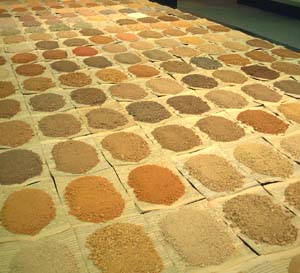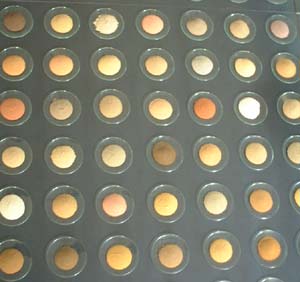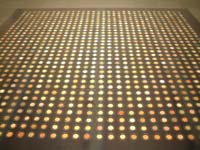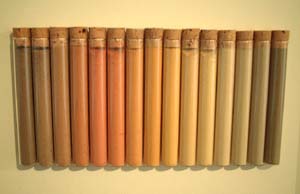
Earth pigments are the oldest paint colors used by humans.
Some 30,000 years ago early Europeans painted animals in the caves near
Chauvet, France. Perhaps as many as 50,000 years ago, Aboriginals collected
the rich red iron and yellow ochre pigments of the earth, mixed them with
a binder such as beeswax or tree sap and painted brilliant rock galleries
of animals and mystic creator spirits. In the oldest continuing artistic
tradition, Aboriginal artists, continue to use natural earth pigments
in their striking contemporary paintings on canvas and on bark panels.
Japanese artist Koichi Kurita uses only the fine powdered particles of
clay in his art. Kurita, formerly a performer, was influenced by the mystical
powers of the earth after a visit in 1992 to the Museum of Natural History,
New York. In this vast treasure trove of nature, rock samples from all
over the earth and beyond are on display. Koichi Kurita has worked solely
with the earth since. He has traveled the world through Africa, Oceania
and Asia researching the links between nature and religion.
His recent exhibition at the INAX gallery in Kyobashi includes a huge
mandala of clay samples. Kurita collected these samples over the past
10 years on journeys around the islands of Japan. After grinding the clay,
he sifts it to produce a fine colored powder. Then by carefully pouring
the powder though a funnel, Kurita makes little piles of colored earth.
Kurita does not organize his work by scientific categories; rather, he
uses a spiritual matrix. Kurita often arranges his clay samples into a
grid-like pattern he describes as a 'mandala' form.
Mandalas are geometric radiating patterns found in Buddhist and Hindu
art. Tibetan monks make highly complex sand mandala paintings using brightly
colored crystal sands. Each mandala, a symbolic representation of nirvana,
may take a team of monks over 5 days to complete. When the work is done,
and after chanting and musical ceremonies the work is swept up into a
bag. The sands are then returned to a river reinforcing the cyclical nature
of life, impermanence of all things and the need for constant renewal.
Kurita describes the making of his works as a performance. More recently,
he has begun firing the clay samples on site in makeshift kilns. The resulting
clay is often burnt and warped but glows in a new aura of hues. In an
installation in the connecting gallery, Kurita places rough dry clay on
pages from books. In other works, Kurita arranges his samples in test
tubes by color Ð from dark to light Ð like a huge box of colored pencils.
Occasionally he labels the regions and places from where they have come.
The link with industry makes the INAX Gallery an interesting art-space.
In its twin galleries, INAX, the maker of most bathroom supplies in Japan
including various ceramic products, emphasizes the links between its building
products and the fine art it displays. This exhibition of work by Kurita
Koichi is an example of how art can open our eyes to new visions of the
ordinary things around us.




